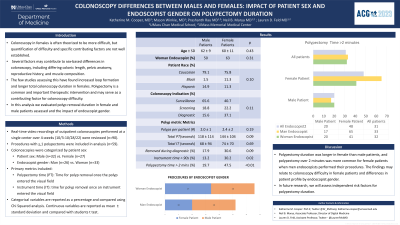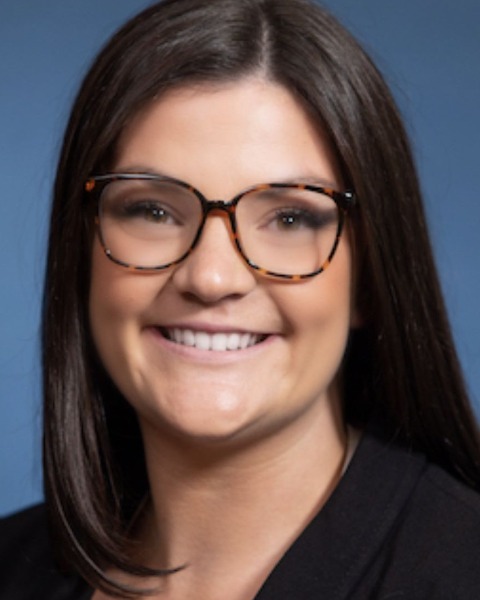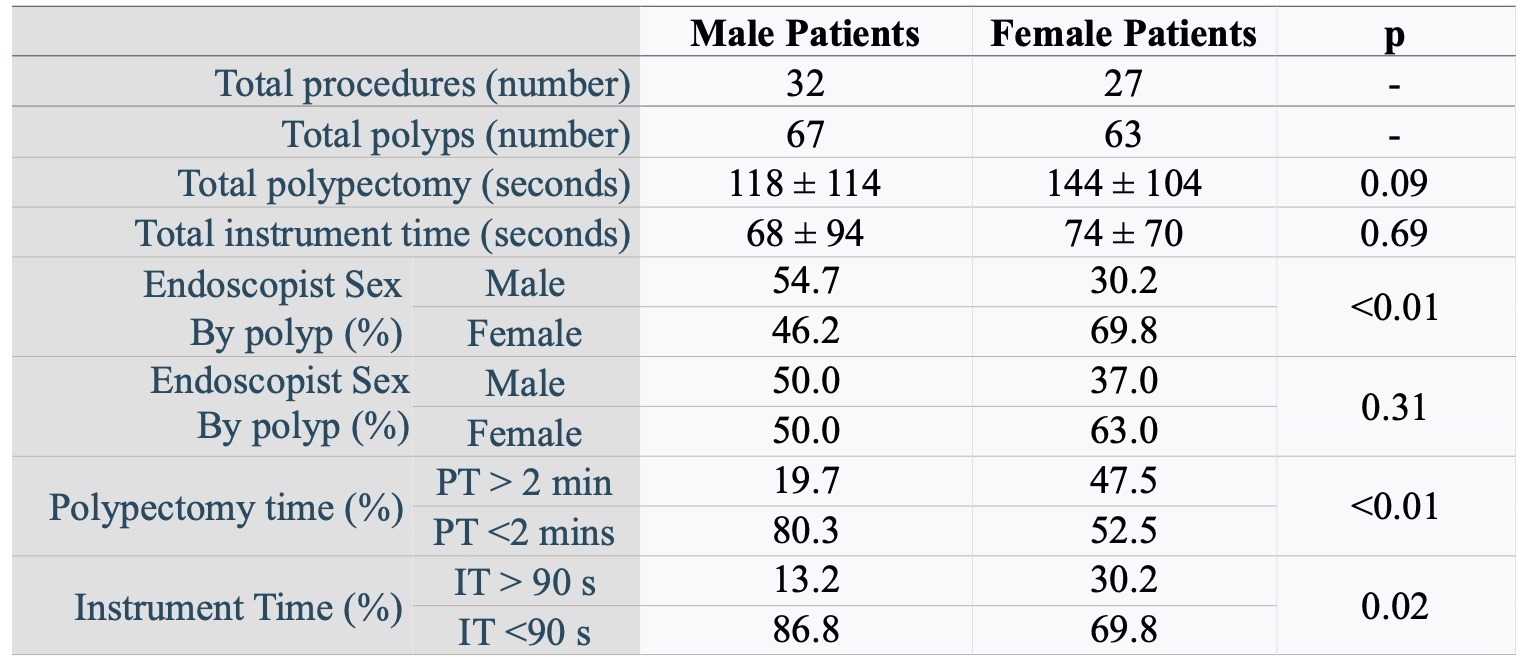Tuesday Poster Session
Category: General Endoscopy
P3394 - Colonoscopy Differences Between Males and Females: Impact of Patient Sex and Endoscopist Gender on Polypectomy Duration
Tuesday, October 24, 2023
10:30 AM - 4:00 PM PT
Location: Exhibit Hall

Has Audio

Katherine M. Cooper, MD
UMass Chan Medical School
Worcester, MA
Presenting Author(s)
Katherine Cooper, MD, Mason Winkie, MD, Prasthanth Rau, MD, Neil Marya, MD, Lauren Feld, MD
UMass Chan Medical School, Worcester, MA
Introduction: Colonoscopy in females is often theorized to be more difficult, but quantification of difficulty and specific contributing factors are not well established. Several factors may contribute to sex-based differences in colonoscopy, including differing colonic length, pelvic anatomy, and muscle composition. The few studies assessing this have found increased loop formation and longer total colonoscopy duration in females. Polypectomy is a common and important therapeutic intervention and may serve as a contributing factor for colonoscopy difficulty. In this analysis, we evaluated polyp removal duration in female and male patients, and the impact of endoscopist gender.
Methods: Real-time video recordings of all colonoscopies performed over a 4-week period (10/3/22-10/28/22) at a tertiary care center were reviewed (n=90). Patients with >=1 polypectomy were included in analysis (n=59). The primary metrics were polypectomy time (PT; time for polyp removal once the polyp entered the visual field) and instrument time (IT; time for polyp removal once an instrument entered the visual field). Endoscopists included 8 women endoscopists (WE) and 5 men endoscopists (ME).
Results: 59 of 90 (66%) patients met inclusion criteria with >=1 polypectomy (32 males, 27 females, all identified as cisgender), with 130 total polyps extracted (males: 67 polyps; females: 63 polyps). WE performed 56% (n=33) of all procedures. Female patients comprised 52% and 38% of the schedule for WE and ME, respectively. Overall, total PT was higher in female patients though with wide confidence intervals (F: 144 seconds vs. M: 118 seconds, p=0.09). Female patients were significantly more likely to have PT ≥ 2-minutes (F:48% vs. M:19%, p< 0.01). Females had PT >=2-minutes in 65% of polyps removed by a ME and 41% removed by a WE (p=0.09) while males had PT ≥2-minutes for 20% of polyps removed by WE and 17% by ME (p = 0.73). Females were also significantly more likely to have IT ≥ 90 seconds (F:30% vs. M:13%, p=0.02).
Discussion: Polypectomy duration was longer in female than male patients. Differences were not confined to the pre-or post-instrument polypectomy phases. The findings may relate to colonoscopy difficulty in female patients. Interestingly, lengthy polypectomy was more common for female patients when men endoscopists performed their procedures. This may be because women endoscopists complete colonoscopies for female patients more frequently. Future research will assess independent risk factors for polypectomy duration.

Disclosures:
Katherine Cooper, MD, Mason Winkie, MD, Prasthanth Rau, MD, Neil Marya, MD, Lauren Feld, MD. P3394 - Colonoscopy Differences Between Males and Females: Impact of Patient Sex and Endoscopist Gender on Polypectomy Duration, ACG 2023 Annual Scientific Meeting Abstracts. Vancouver, BC, Canada: American College of Gastroenterology.
UMass Chan Medical School, Worcester, MA
Introduction: Colonoscopy in females is often theorized to be more difficult, but quantification of difficulty and specific contributing factors are not well established. Several factors may contribute to sex-based differences in colonoscopy, including differing colonic length, pelvic anatomy, and muscle composition. The few studies assessing this have found increased loop formation and longer total colonoscopy duration in females. Polypectomy is a common and important therapeutic intervention and may serve as a contributing factor for colonoscopy difficulty. In this analysis, we evaluated polyp removal duration in female and male patients, and the impact of endoscopist gender.
Methods: Real-time video recordings of all colonoscopies performed over a 4-week period (10/3/22-10/28/22) at a tertiary care center were reviewed (n=90). Patients with >=1 polypectomy were included in analysis (n=59). The primary metrics were polypectomy time (PT; time for polyp removal once the polyp entered the visual field) and instrument time (IT; time for polyp removal once an instrument entered the visual field). Endoscopists included 8 women endoscopists (WE) and 5 men endoscopists (ME).
Results: 59 of 90 (66%) patients met inclusion criteria with >=1 polypectomy (32 males, 27 females, all identified as cisgender), with 130 total polyps extracted (males: 67 polyps; females: 63 polyps). WE performed 56% (n=33) of all procedures. Female patients comprised 52% and 38% of the schedule for WE and ME, respectively. Overall, total PT was higher in female patients though with wide confidence intervals (F: 144 seconds vs. M: 118 seconds, p=0.09). Female patients were significantly more likely to have PT ≥ 2-minutes (F:48% vs. M:19%, p< 0.01). Females had PT >=2-minutes in 65% of polyps removed by a ME and 41% removed by a WE (p=0.09) while males had PT ≥2-minutes for 20% of polyps removed by WE and 17% by ME (p = 0.73). Females were also significantly more likely to have IT ≥ 90 seconds (F:30% vs. M:13%, p=0.02).
Discussion: Polypectomy duration was longer in female than male patients. Differences were not confined to the pre-or post-instrument polypectomy phases. The findings may relate to colonoscopy difficulty in female patients. Interestingly, lengthy polypectomy was more common for female patients when men endoscopists performed their procedures. This may be because women endoscopists complete colonoscopies for female patients more frequently. Future research will assess independent risk factors for polypectomy duration.

Figure: Colonoscopy metrics by patient sex
Disclosures:
Katherine Cooper indicated no relevant financial relationships.
Mason Winkie indicated no relevant financial relationships.
Prasthanth Rau indicated no relevant financial relationships.
Neil Marya: Boston Scientific – Consultant.
Lauren Feld indicated no relevant financial relationships.
Katherine Cooper, MD, Mason Winkie, MD, Prasthanth Rau, MD, Neil Marya, MD, Lauren Feld, MD. P3394 - Colonoscopy Differences Between Males and Females: Impact of Patient Sex and Endoscopist Gender on Polypectomy Duration, ACG 2023 Annual Scientific Meeting Abstracts. Vancouver, BC, Canada: American College of Gastroenterology.
